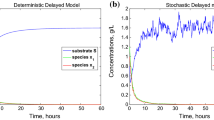Abstract
In this paper, a three dimensional ratio-dependent chemostat model with periodically pulsed input is considered. By using the discrete dynamical system determined by the stroboscopic map and Floquet theorem, an exact periodic solution with positive concentrations of substrate and predator in the absence of prey is obtained. When β is less than some critical value the boundary periodic solution (x s (t), 0, z s (t)) is locally stable, and when β is larger than the critical value there are periodic oscillations in substrate, prey and predator. Increasing the impulsive period τ, the system undergoes a series of period-doubling bifurcation leading to chaos, which implies that the dynamical behaviors of the periodically pulsed ratio-dependent predator-prey ecosystem are very complex.
Similar content being viewed by others
References
Bavinov D D, Simeonov D D. Impulsive Differential Equations: Periodic Solutions and Applications, England: Longman, 1993.
Lakshmikantham V, Bavinov D D, Simeonov P C. Theory of Impulsive Differential Equations, Singapore: World Scientific, 1989.
Tang S Y, Chen L S. Density-dependent birth rate, birth pulse and their population dynamic consequences, J Math Biol, 2002, 44:185–199.
Roberts M G, Kao R R. The dynamics of an infectious disease in a population with birth pulses, Math Biosci, 1998, 149: 23–36.
Shulgin B, Stone L, Agur Z. Pulse vaccination strategy in the SIR epidemic model, Bull Math Biol, 1998, 60: 23–26.
D’Onofrio A. Stability properties of pulse vaccination strategy in SEIR epidemic model, Math Biosci, 2002, 179: 57–72.
Panetta J C. A mathematical model of periodically pulsed chemotherapy: tumor recurrence and metastasis in a competitive environment, Bull Math Biol, 1996, 58: 425–447.
Lakmeche A, Arino O. Bifurcation of non trivial periodic solutions of impulsive differential equations arising chemotherapeutic treatment, Dynamics of Continuous, Discrete and Impulsive Systems, 2000, 7: 165–187.
Ballinger G, Liu X. Permanence of populaton growth models with impulsive effects, Math Compute Modelling, 1997, 26: 59–72.
Bardi M. Predator prey models in periodically fluctuating environments, J Math Biol, 1981, 12: 127–140.
Cushing J M. Periodic Kolmogorov system, SIAM J Math Anal, 1982, 13: 811–827.
Pavlou S, Kevrekidis I G. Microbial predation in a periodically operated chemostat: a global study of the interaction between natural and externally imposed frequencies, Math Biosci, 1992, 108: 1–55.
Rinaldi S, Muratori S, Kuznetsov Y A. Multiple, attraction, catastrophes, and chaos in seasonally perturbed predator-prey communities, Bull Math Biol, 1993, 55: 15–36.
Kot M, Sayler G S, Schultz T W. Complex dynamics in a model microbial system, Bull Math Biol, 1992, 54: 619–648.
Funasaki E, Kor M. Invasion and chaos in periodically pulsed mass-action chemostat, Theor Popul Biol, 1993, 44: 203–224.
Liu X N, Chen L S. Complex dynamics of Holling type II Lotka-Volterra predator-prey system with impulsive perturbations on the predator, Chaos, Soliton and Fractals, 2003, 16: 311–320.
Zhang S W, Dong L Z, Chen L S. The study of predator-prey system with defensive ability of prey and impulsive on the predator, Chaos, Soliton and Fractals, 2005, 23: 631–643.
Wang F X, Zhang S W, Chen L S, et al. Permanence and complexity of a three species food chain with impulsive effect on the top predator, Int J Nonlinear Sci Number Simul, 2005, 6(2): 169–180.
Bavinov D D, Simenov P S. Impulsive Differential Equations: Periodic Solutions and Applications, New York: John Wiley and Sons, 1993.
Venkatesan A, Parthasarathy S, Lakshmanan M. Occurrence of multiple period-doubling bifurcation route to chaos in periodically pulsed chaotic dynamical systems, Chaos, Soliton and Fractals, 2003, 18: 891–898.
Author information
Authors and Affiliations
Additional information
Supported by the National Natural Science Foundation of China (10471117), the Henan Innovation Project for University Prominent Research Talents(2005KYCX017) and the Scientific Research Foundation of Education Ministry for the Returned Overseas Chinese Scholars.
Rights and permissions
About this article
Cite this article
Zhao, Z., Song, X. Bifurcation and complexity in a ratio-dependent predator-prey chemostat with pulsed input. Appl. Math.- J. Chin. Univ. 22, 379–387 (2007). https://doi.org/10.1007/s11766-007-0401-4
Received:
Issue Date:
DOI: https://doi.org/10.1007/s11766-007-0401-4




